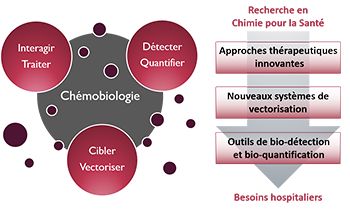- ⌂
-
Le DPM
Les Equipements
L'Environnement
Zoom sur... Le Bâtiment André Rassat
Nommé d'après une figure tutélaire de la chimie grenobloise, ce bâtiment est recouvert d’une double peau en feuille métallique qui apporte une protection thermique sur 3 côtés et crée une unité architecturale favorisant l'intégration parmi les arbres du site.
-
Thématiques
Le Thème
« Approches thérapeutiques innovantes »De nouvelles solutions thérapeutiques, de la cible biomacromolécu-laire émergente aux approches originales pour traiter les maladies
Le Thème
« Nouveaux systèmes de vectorisation »Combiner les propriétés d’inclusion de principes actifs, de franchisse-ment de barrières, d’adressage et de relar-gage en milieu vivant
Le Thème
« Outils de bio-détection et bio-quantification »Des dispositifs analytiques originaux pour la détection de cibles, de l’ion au micro-organisme en milieu complexe
Zoom sur... La Chémobiologie

-
Équipes
L'Équipe « COMET »
« COMET » développe la conception rationnelle, la synthèse et/ou l'extraction de composés à forte diversité/complexité comme nouveaux agents thérapeutiques et outils moléculaires pour la pénétration cellulaire ou la détection de biomolécules, actifs in vivo.L'Équipe « NOVA »
« NOVA » utilise des acides nucléiques fonctionnels comme éléments de reconnaissance pour des applications thérapeutiques ou diagnostiques, comme la sélection d'oligonucléotides, ou le développement de dispositifs d'analyses et de nanovecteurs.Les Services
-
Productions
Les Publications
La Vulgarisation
Les JSM
Zoom sur... La 12ème JSM (15 juin 2023)
Le DPM organise des journées scientifiques consacrées au médicament. L'objectif est de rassembler les spécialistes académiques et industriels autour d'une thématique. 2023 : Apports de la Chimie Click et de la Lumière en Chemobiologie
-
Partenariats
Les Formations
Les Consortiums
Les Financements
Zoom sur... L'environnement Grenoblois
Le DPM est un acteur central sur le bassin grenoblois en chimie, biologie et santé, lié au CHU Grenoble Alpes et à de nombreuses autres organisations : Pole de Recherche CBS, ICMG, Labex ARCANE, EUR CBH, Institut Carnot Polynat, Réseau GREEN.
Article
- Projet
- Denis WOUESSIDJEWE, Luc CHOISNARD,
- Titre
- Single Crystals of V-Amylose Complexed with Bicyclic Organic Compounds. Special Issue: Polymer‐Solvent Complexes and Intercalates
-
[Full paper
 ]
] - Auteurs
- Cong‐Anh‐Khanh Le Luc Choisnard Denis Wouessidjewe Jean‐Luc Putaux
- Pages
- 1-7
- Tome
- 386
- Collection
- Macromolecular Symposia - Electron Crystallography
- Editeurs
- WILEY-VCH Verlag GmbH & Co. KGaA, Weinheim
- Edition
- MACROMOLECULAR SYMPOSIA
- Année
- 2019
- Résumé
- Lamellar single crystals of V-amylose were prepared from dilute aqueous solutions in the presence of selected bicyclic compounds. Transmission electron microscopy images as well as electron and X-ray diffraction patterns revealed that two allomorphs containing 7-fold amylose single helices were formed depending on the complexing agent. On the one hand, trans-decalin and (-)-beta-pinene induced the crystallization of an orthorhombic unit cell isomorphous to that of V2-propanol crystals reported in the literature (referred to as V7(II)). On the other hand, (+)-camphor and (-)-borneol yielded a new compact pseudo-hexagonal structure (referred to as V7(I)). Cis-decahydro-1-naphthol and decahydro-2-naphthol induced the formation of both allomorphs. V7(I) was favored at a higher crystallization temperature compared to V7(II). Upon drying in vacuum, both V7(I) and V7(II) converted into the hexagonal anhydrous allomorph V7(a) but the initial structures were recovered by rewetting the crystals in water at room temperature. In addition, washing the crystals with methanol resulted in a transition from a 7-fold to a 6-fold helical conformation of amylose. The results suggest that both water and complexing agent play an important role on the formation and stability of V-amylose crystals.




 Annuaire
Annuaire Contact
Contact Plan d'accès
Plan d'accès ENG
ENG Login
Login



